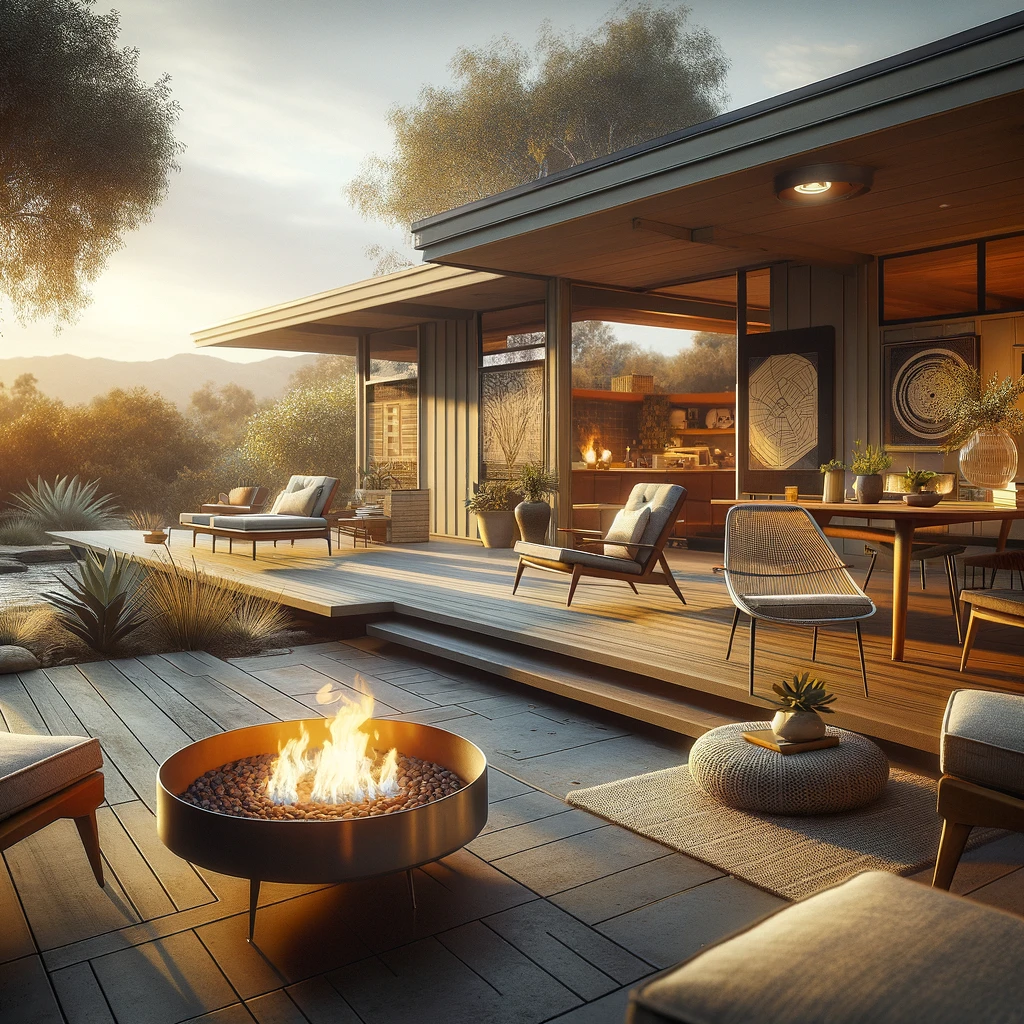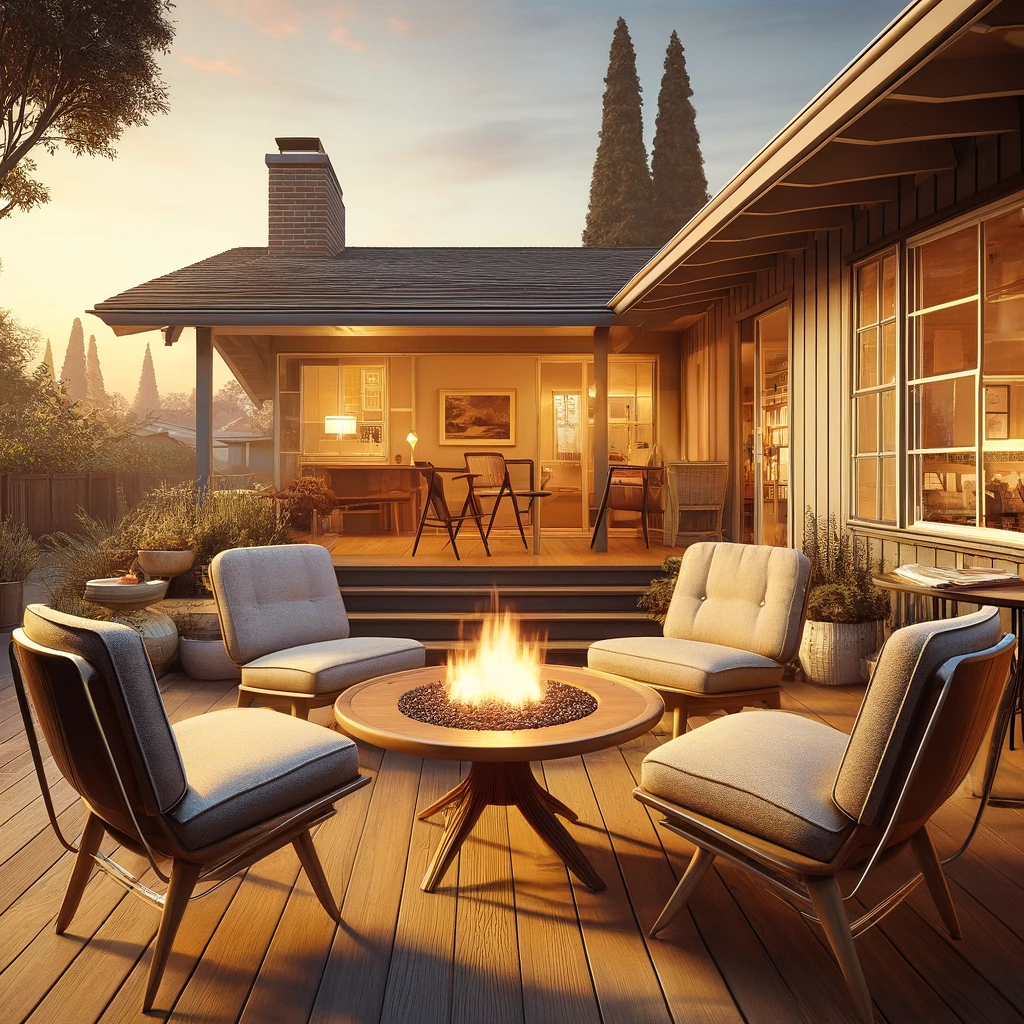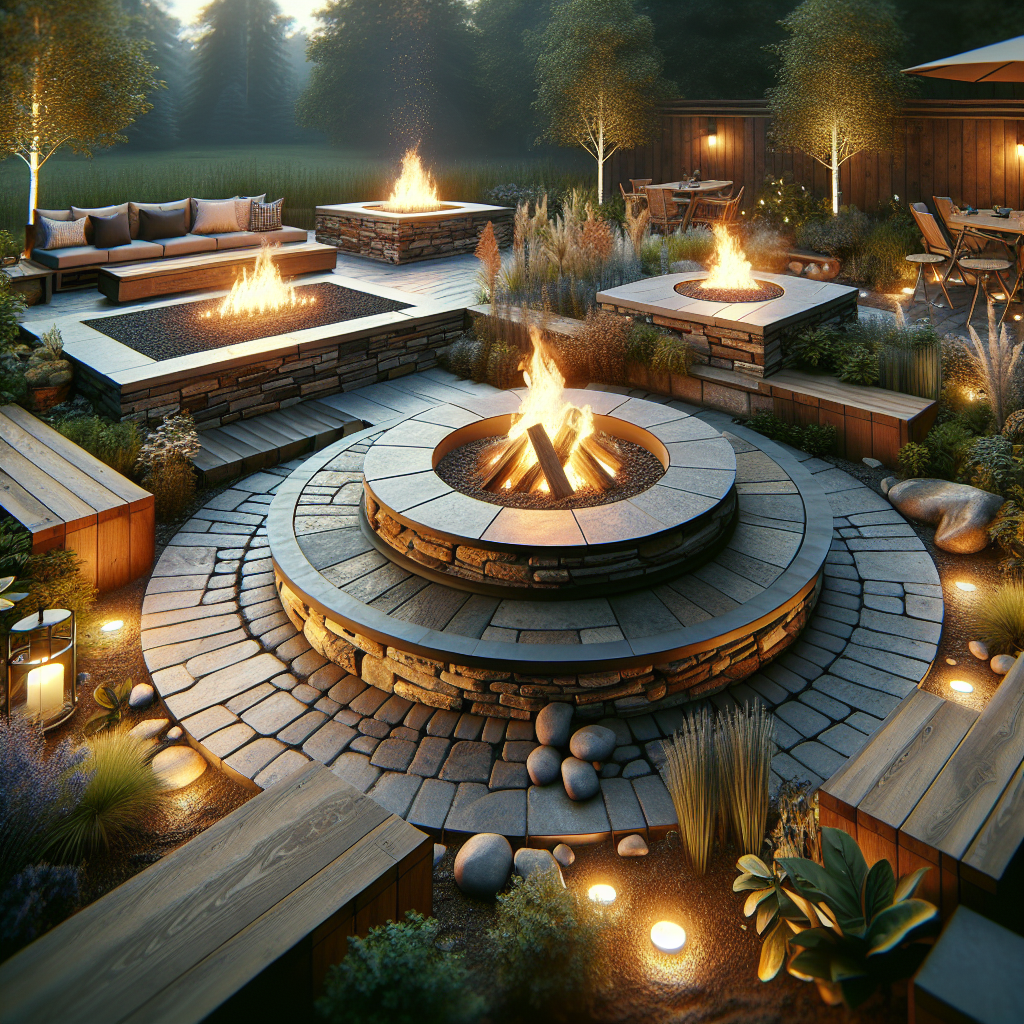Introduction: At the Heart of Outdoor Living
As we increasingly value our outdoor spaces for relaxation and entertainment, features like an outdoor fire pit become much more than just trendy. But what exactly is an outdoor fire pit, and what does it bring to your backyard?
How should you choose the right outdoor fire pit, and is it worth investing at all?
In this comprehensive guide, we’ll take you through the basics and the benefits of owning an outdoor fire pit. We will also explore the considerations you must make in terms of maintenance and safety. And if an outdoor feature doesn’t suit your home or lifestyle, we’ll also introduce you to the classic alternative: the indoor fireplace.
So, are you ready to bring the warmth and glow of a fire into your living space? Let’s venture into the world of fire pits and fireplaces.
Table of Contents
Exploring the Construction Concept: An Outdoor Fire Pit

Definition of an Outdoor Fire Pit
An outdoor fire pit is essentially a constructed feature that forms part of your outdoor living space. The purpose of it is to provide a safe, controlled environment for fire.
Typically, people make use of an outdoor fire pit for warmth, cooking, and aesthetically enhancing the backyard ambiance during social gatherings. It’s an essential element, especially for those chilly evenings when you’re entertaining guests.
Main Characteristics of an Outdoor Fire Pit
There are several defining characteristics that separate an outdoor fire pit from other types of structures.
Design
The design is one of the first things you’ll notice. While the details can vary, the typical outdoor fire pit is a hole or a pit that is dug into the ground or built up above ground level. There’s that characteristic circular or square structure that embraces the fire.
Material
Outdoors fire pits are crafted from a variety of materials. Some of the most common ones used are:
- Stone
- Bricks
- Metal (like cast iron or steel)
- Concrete
- Some types of outdoor-safe glass
Location
Usually, an outdoor fire pit is positioned in an open part of the backyard, far from flammable structures or plants. Its position allows for 360-degree access.
Types of Outdoor Fire Pits
There are different types of outdoor fire pits, each with its unique design and function.
| Type | Characteristic |
|---|---|
| Wood-burning fire pits | These are the more traditional versions, which produce a ‘campfire’ atmosphere and provide a natural way to cook. |
| Propane fire pits | Propane fire pits run on gas and are easy to use and maintain. Nevertheless, they do not provide the authentic ‘wood-burning’ experience. |
| Gel fuel fire pits | Gel fuel pits are smaller, portable, and affordable. These offer a good option if you’re not looking for a big commitment or have space constraints. |
An outdoor fire pit can be a fun and useful addition to your backyard. When choosing a fire pit, consider your style, space, budget, and how you plan to use it.
Benefits of Owning an Outdoor Fire Pit
Enhances Backyard Aesthetic
Adding an outdoor fire pit not only elevates the functionality of your backyard but also boosts its aesthetic appeal. With multiple design options and materials to choose from, you can create a centerpiece that complements your outdoor decor and style.
Entertainment Value
From hosting backyard parties to creating cozy family gatherings, a fire pit serves as an inviting spot. It can become a focal point of your gatherings, leading to unforgettable nights of roasting marshmallows, grilling, or simply chatting around the fire.
Increases Property Value
Outdoor fire pits tend to be highly desirable elements for potential homebuyers. They can significantly increase the appeal of a property and consequently, its value. Consider this as an investment that yields both immediate pleasure and long-term returns.

The Considerations: Maintenance and Safety
Fire Pit Maintenance
Just like any other outdoor feature, an outdoor fire pit requires regular checkups and cleaning.
Maintenance Based on Material
The type of material used will determine the level of maintenance needed. For instance:
- Metal fire pits will need regular checks for any signs of rust
- Stone or concrete pits require a careful look for cracking and erosion
Fire Safety
While fire pits add a charming element to your outdoor setup, they also demand attentiveness to fire safety rules.
Use a Spark Screen
To prevent stray sparks from causing potential harm, ensure to use a heat-resistant grate or spark screen when the fire is active.
Have a Fire Extinguisher Handy
Always have safety equipment nearby when firing up your pit. Having a fire extinguisher or a bucket of sand at an arm’s length ensures you can promptly act on sudden fire mishaps.
So, Is an Outdoor Fire Pit Worth It?
The answer to the question above rests on individualize preferences and lifestyle choices. However, weighing the benefits against the involved considerations prepares you for an informed decision.
If you favor outdoor living and appreciate the charm and comfort of a warm, controlled fire, maintaining a fire pit would be worth the extra effort and investment. Conversely, for a household where outdoor activities are sparse, this amenity may appear as a needless luxury.
Remember, the enjoyment derived from owning a fire pit will balance out its demands when employed as per the preferable usage. While the endeavor necessitates a handful of tasks, the highlighted benefits proclaim the addition of an outdoor fire pit significantly rewarding in the longer run.

Decoding the Best Fire Pit Style
Which Fire Pit Style Reigns Supreme?
Determining the “best” fire pit often boils down to personal preference and specific needs. However, when comparing functionality, maintenance, and aesthetic versatility, some styles stand out.
Wood-Burning Fire Pits for Tradition
Perfect for nostalgic campfire lovers, wood-burning fire pits bring traditional charm. They excel in delivering an authentic experience, with the crackling sound of firewood and the smoky scent. These fire pits also allow for natural cooking over flames.
However, wood-burning pit style demands considerable maintenance. They require ash removal post-fire and occasional checks for any creosote build-up. It is also crucial to have a continuous source of good-quality wood for fuel.
Propane Fire Pits for Convenience
Propane fire pits offer ease and convenience. They quickly light up with a push button and do not generate any smoke, ashes, or residue, hence diminishing cleaning chores. Convertibility is a plus, with some models allowing alteration to natural gas.
However, the accompanying propane tanks may be cumbersome, and refills can be expensive. While they produce heat, they can’t match the intensity of wood-burning units, affecting their warmth output in colder climates.
Gel Fuel Fire Pits for Flexibility
If you’re dealing with space constraints or wish for a portable unit, gel fuel fire pits may be your answer. They are compact, lightweight, and require minimal maintenance. Gel fuels are also smokeless and leave no residue.
However, their heat output is low compared to others, making them inappropriate for larger spaces. Plus, they lack the traditional fire experience as they lack actual flames and the comforting sound of crackling firewood.

Factors Impacting the Final Choice
Space and Placement
One of the primary considerations while choosing a fire pit style is the available space. For smaller spaces, gel or propane fire pits might be more suitable due to their compact sizes and less emission of sparks. For larger, open spaces, wood-burning pits can be an excellent fit.
Local Codes and Regulations
Before you invest in a fire pit, familiarize yourself with local codes and regulations. Some areas may have restrictions on open fires or use of specific fuels.
Budget
Each type of fire pit comes with its associated costs. Stone and brick fire pits may require professional installation, driving up the cost. Propane fire pits incur the ongoing costs of fuel but typically require less hands-on maintenance. Another cost to consider is the potential increase of your home insurance, as some companies might regard a fire pit as an added risk.
Customized or Pre-fabricated: Which One is Better?
Customized Fire Pits
A custom-built fire pit can be tailored to your exact needs and aesthetics. Choices of shape, materials, size, and fuel type are in your hands. They often become integrated landscape features, potentially enhancing the overall property value. However, customization often comes with higher costs and typically requires professional installation.
Pre-fabricated Fire Pits
Pre-fabricated fire pits are typically more affordable and quicker to set up. They offer a variety of styles, materials, and fuel types, catering to a range of preferences. While not unique to your space, they can still be attractive and functional additions to your garden. But repair and replacement parts may become a concern if the fire pit is an unusual model or from an obscure brand.
In the end, deciding on the best fire pit style boils down to circumstances, preferences, and budget. Each fire pit has its strengths that can cater to specific needs.

Indoor Fireplaces: A Classic Alternative to Outdoor Fire Pits
An Introduction to Indoor Fireplaces
While outdoor fire pits provide a unique charm, indoor fireplaces stand as their classic and cozier alternative. An indoor fireplace refers to a kind of structure that burns fuel, most commonly wood or gas, to produce heat indoors. It’s a traditional heat source that has kept homes warm for centuries, but today, fireplaces also serve an important decorative purpose.
Design
Indoor fireplaces come in a variety of designs that can fit virtually any interior style. Whether it’s a rustic stone construction for a traditional feel or a sleek, modern design that fits perfectly into contemporary settings, there are countless options available.
Material
Indoor fireplaces come in numerous finishes and materials. Some popular choices include:
- Stone
- Brick
- Metal (such as cast iron or stainless steel)
- Marble or limestone for a more luxurious finish
Types of Indoor Fireplaces
Just like outdoor fire pits, indoor fireplaces also come in multiple types, each with their own unique features.
| Type | Characteristic |
|---|---|
| Wood-burning fireplaces | These are the traditional type of fireplace, offering a charming aesthetic along with the comforting sound and smell of burning wood. |
| Gas fireplaces | Gas fireplaces are a popular choice due to their convenience. They offer the ambiance of a wood-burning fireplace but with instant ignition and control over flame height. |
| Electric fireplaces | For those not looking for the mess or maintenance of a traditional fire, electric fireplaces offer an affordable and convenient alternative. They offer a simulated flame effect and produce heat using electricity. |
Advantages of Indoor Fireplaces
Heat Efficiency
Indoor fireplaces are typically more heat efficient when compared to outdoor fire pits. They distribute heat throughout the house and provide a comforting ambience, making them ideal during cold winter months.
Increasing Aesthetic Appeal and Property Value
Indoor fireplaces can add significant aesthetic value to any space. They usually serve as focal points in living rooms and can increase property value, just as outdoor fire pits do.
The Considerations: Installation and Maintenance
Installing an Indoor Fireplace
Installing an indoor fireplace often requires professional help. The process can involve substantial alterations to the home, including the provision of a chimney or venting system.
Maintenance
Like outdoor fire pits, indoor fireplaces also require regular maintenance. This can include clearing out ashes for wood-burning units and regular safety inspections for gas and electric models.

Choosing the Right Fireplace for Your Space
Selecting the right fireplace involves considering a multitude of factors, including:
Space and Home Layout
The size of your home, available space, and the room layout all play a crucial role in deciding the size and location of the fireplace. It’s crucial to ensure that the fireplace doesn’t congest the room but instead enhances its overall appeal.
Cost
Cost is a major consideration when installing an indoor fireplace. This includes not just the initial cost of purchasing and installing the fireplace, but also the ongoing cost of fuel and regular maintenance.
Heat Output and Efficiency
The required heat output of the fireplace is another important factor to consider. Different types of fireplaces produce different amounts of heat, so choosing the right one will depend on your home’s heating needs.
An indoor fireplace can provide both warmth and a homely aesthetic, making it a great alternative to an outdoor fire pit. It’s a classic choice that, despite its drawbacks, stands out for its ambiance and comforts. Depending on the room size, interior decoration style, and your needs, a well-selected indoor fireplace can be a fantastic addition to your living space.
In Conclusion: The Versatility of Fire Features
In this in-depth exploration of fire features, we’ve considered the pros and cons of outdoor fire pits and indoor fireplaces. Whether you prefer the intimate gatherings around an outdoor fire pit, appreciate the traditional charm of a wood-burning fireplace, or enjoy the convenience of a propane or gel fire pit, the right fire feature can significantly enhance your living space.
Remember, choosing the right fire feature goes beyond aesthetics – consider your lifestyle, budget, space availability, and local regulations. With appropriate safety measures and regular maintenance, an outdoor fire pit or indoor fireplace can be a rewarding investment, providing warmth, comfort, and an inviting atmosphere for countless cozy nights spent with family and friends.
What are the main benefits of an outdoor fire pit?
An outdoor fire pit can bring a touch of cozy ambiance, serves as an attractive centerpiece for your backyard, and provides warmth for outdoor gatherings. Additionally, having an outdoor fire pit can potentially improve your property’s value.
What considerations should be made before installing an outdoor fire pit?
Important considerations include available space, local fire safety regulations, proximity to flammable materials, type of fire pit, and your intended use for it. Also, remember to have safety equipment, like a fire extinguisher or a bucket of sand, readily available.
Are indoor fireplaces a valid alternative to outdoor fire pits?
Absolutely! Indoor fireplaces offer warmth, increase aesthetic appeal, and can also raise property value, similar to outdoor fire pits. They are especially beneficial during colder months when staying indoors is preferable. Your choice will depend on your specific needs and preferences.
What factors to consider when installing an indoor fireplace?
Key factors include room size, home layout, initial installation costs, ongoing fuel and maintenance costs, as well as heat output, not forgetting the aesthetic and style considerations to ensure it complements your home’s interior design.






